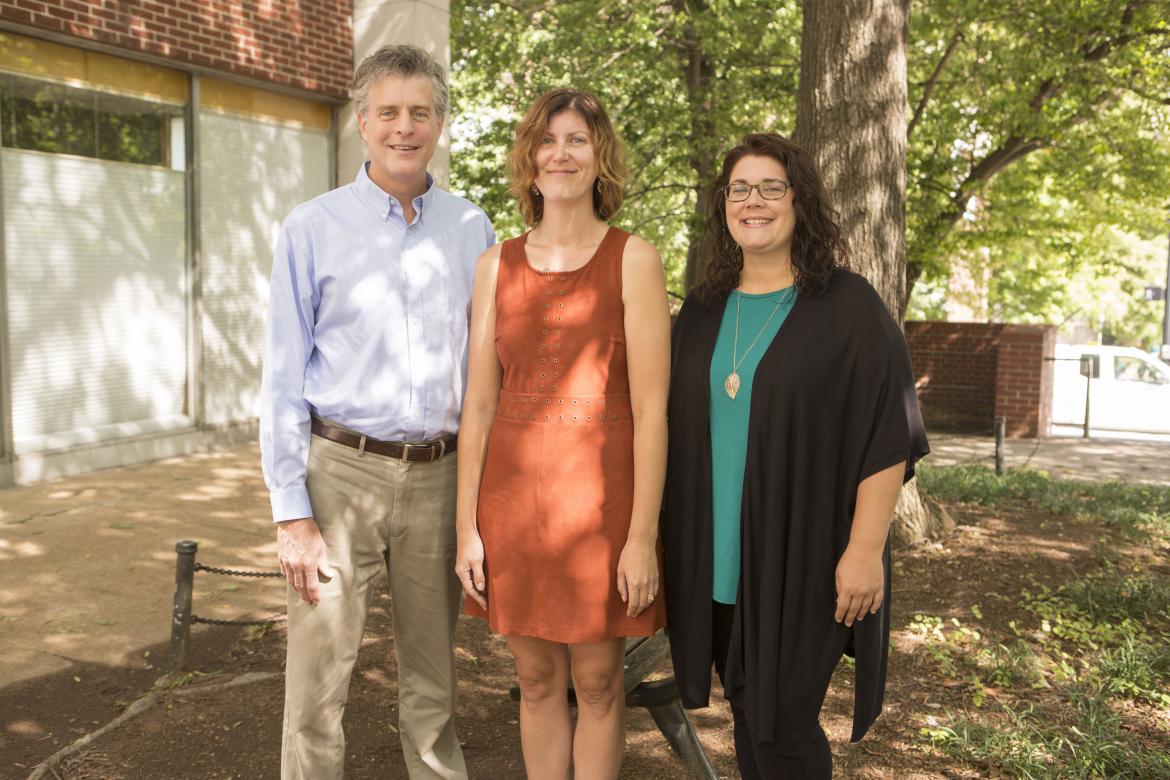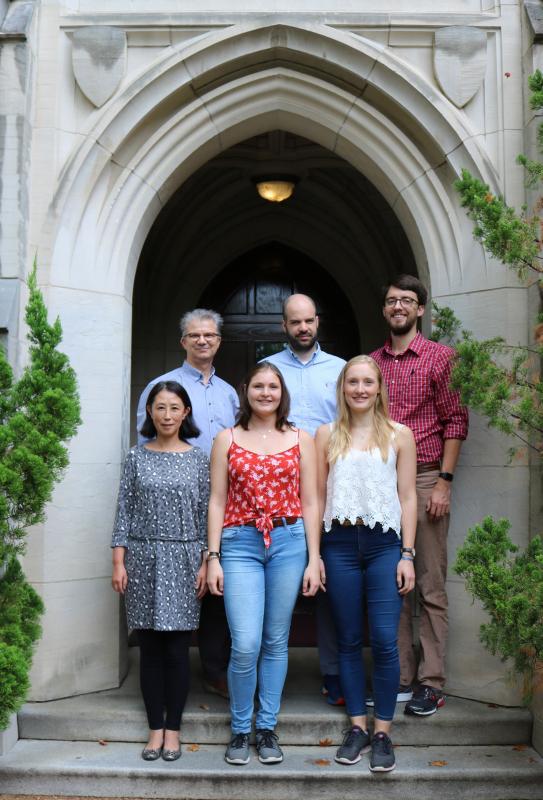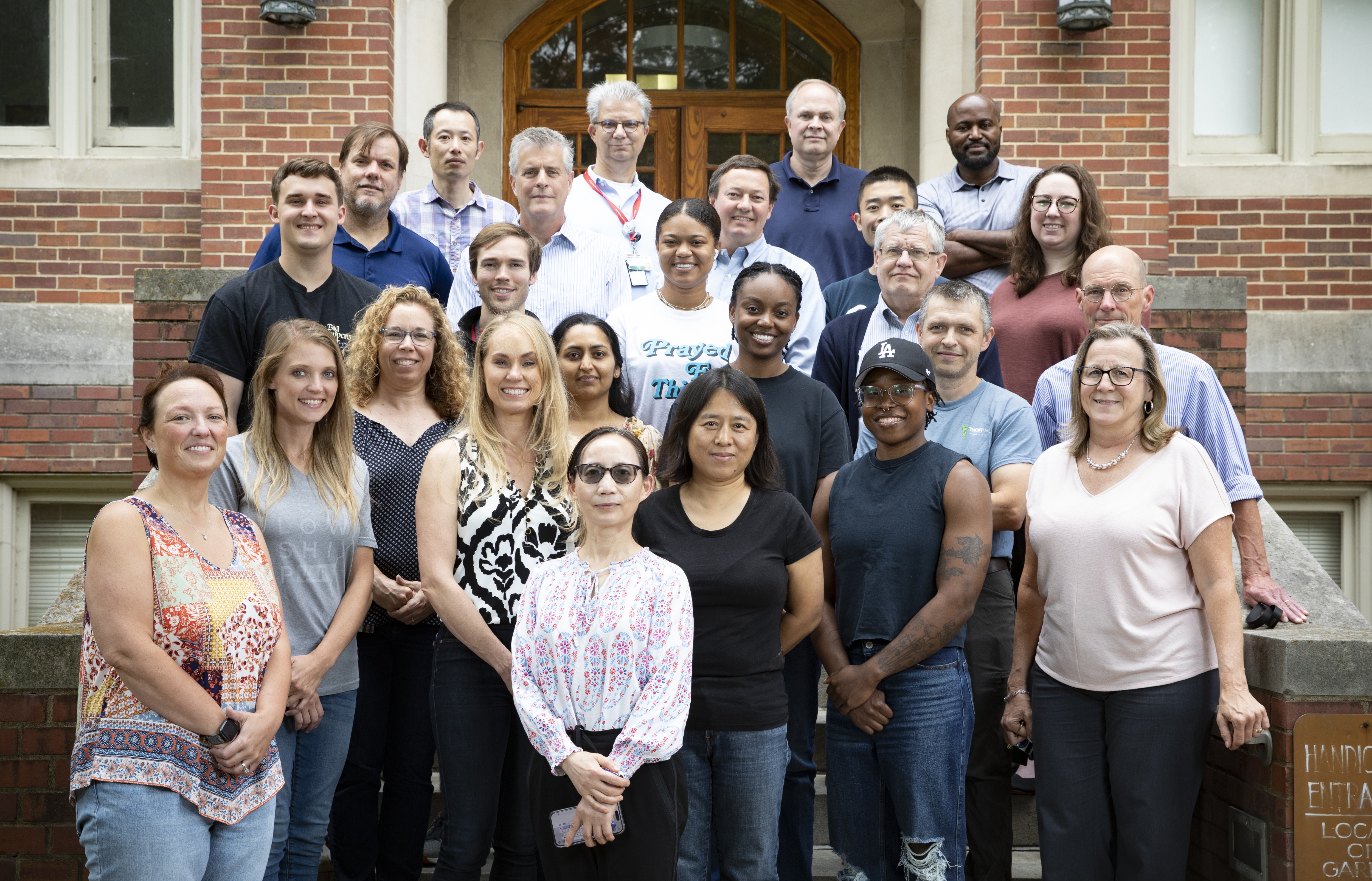The Vanderbilt Anesthesiology Basic Molecular Research program was established to build bridges between clinical and basic sciences. Anesthesiologists and intensivists are confronted with a vast array of patient diseases during the process of surgical and intensive care. Modern anesthesiology and critical care medicine depend upon translational knowledge derived at the interface between patient care and the basic research laboratory.
Basic scientists in the department have extensive expertise in electrophysiology, digital microscopy, molecular biology, neurophysiology, genetics and cellular-, organ system-, and integrative physiology. Our scientists are well-funded by the National Institutes of Health, American Heart Association, and other extramural sources. The philosophy of the department’s basic research program is to define fundamental aspects of physiology at the molecular and cellular level, and where appropriate, to ensure that this knowledge is translated into improved patient care.
Basic research activities in the department focus broadly on cell membrane physiology, neuroscience and cardiovascular physiology. Current research efforts include drug discovery for ion channels; structure/function analysis of voltage-gated Cl-, Na+ and K+ channels; molecular physiology of cation-coupled chloride cotransporters and their role in GABAergic neurotransmission; and physiological and molecular characterization of neurosecretion and its regulation by G proteins and Ca2+. Edward Sherwood, MD, PhD, was named Vice Chair of the Research Division in July 2012. Eric Delpire, PhD, Professor of Anesthesiology & Molecular Physiology & Biophysics, was named the department’s Director of Basic Science Research in 2010. Delpire has been a member of the Vanderbilt University Medical School faculty since 1997.
-
Julia Bohannon joined the Anesthesiology department as a postdoctoral fellow under Dr. Ed Sherwood in 2012. She became junior faculty in 2015 and now has her own research program aimed at investigating immunomodulatory therapies for the prevention of infection and sepsis following a severe burn injury. Infection is the leading cause of death and prolonged hospitalization in severely burned patients that survive the acute phase of injury. Loss of the skin barrier, impaired innate immunity and the prevalence of antibiotic resistant bacteria increase the susceptibility of burn patients to serious infection, leading to a great need for immunomodulation strategies aimed at priming the host response in these patients. Priming with Toll-like receptor 4 agonists have been shown to augment neutrophil antimicrobial responses and enhance resistance against infection after severe burn injury in mice. However, the role of the classical MyD88- and TRIF-dependent TLR signaling cascades in mediating this protection, are not fully understood. Preliminary studies support a primary role for MyD88-signaling in mediating antimicrobial responses, potentially through augmentation of leukocyte metabolism, but the cellular and molecular mechanisms involved are unclear. The Bohannon lab utilizes multiple post-burn murine infection models, including a Pseudomonas aeruginosa burn wound infection as well as Staphylococcal aureus and Candida albicans systemic infections, to assess the effect of various TLR agonists on mediating protection against infection. The information gained from this project will advance current knowledge by elucidating the role played by the two primary TLR signaling pathways in mediating resistance to infection in burn patients, and by investigating the potential of harnessing these pathways for therapeutic benefit in these patients. These studies will also fill important gaps in knowledge by improving our understanding of how TLR agonists modulate innate immune responses.
-

The work in Dr. Bruehl’s lab is focused on the general topic of pain and pain management. For the past several years, a key focus of his lab has been on understanding various factors (e.g., natural opioid system function, psychosocial status) that may influence the benefits versus risks experienced when receiving opioid analgesic medications for pain management. Ongoing work is evaluating whether aerobic exercise training reduces chronic back pain by enhancing natural opioid systems (endogenous opioids), and is testing whether exercise-related endogenous opioid enhancements can reduce the dosage of opioid analgesic medication required to achieve adequate pain management. Dr. Bruehl’s lab is also collaborating with other researchers to better understand the impact of genetic factors on both the analgesia and side effects experienced when receiving opioid analgesic medications.
Another key focus of the Bruehl lab is on evaluating whether oxidative stress occurring during total knee arthroplasty surgery (TKA) contributes to chronic pain that occurs in a subset of patients after TKA, with a particular focus on the condition known as Complex Regional Pain Syndrome.
Dr. Bruehl’s lab also continues to investigate how chronic pain alters cardiovascular function and impairs normally adaptive interactions between the cardiovascular and pain regulatory systems. This work seeks to better understand the causes of increased hypertension risk in chronic pain sufferers.
Finally, work in the Bruehl lab has extensively evaluated the impact of anger-related factors on both acute and chronic pain, and has explored the role of endogenous opioids in observed relationships between emotional regulation and pain responses.
Overall, the goal of the research in Dr. Bruehl’s lab is to better understand the psychophysiological factors contributing to chronic pain and its related health risks, and ultimately, to improve treatment of chronic pain while mitigating against the risks associated with regular opioid analgesic use.Click here to access the Pain Research Group page.
-
GABAergic neurotransmission depends upon the transmembrane Cl concentration gradient that exists at the synapse. The intracellular Cl concentration in CNS and PNS neurons is regulated, in part, by cation-chloride cotransport mechanisms such as Na-K-2Cl and K-Cl cotransporters. For example, the inward Na-K-2Cl cotransporter is highly expressed in immature CNS neurons, resulting in a high intracellular Cl- concentration and GABA depolarizing or excitatory responses. In contrast, mature CNS neurons have low Na-K-2Cl cotransporter and high K-Cl cotransporter leading to low intracellular Cl- and GABA hyperpolarizing or inhibitory responses.
The Delpire Laboratory is creating and studying genetically-modified mouse models of the cotransporters and of proteins that regulate them. The work, involves molecular biology, physiology, electrophysiology and behavior. These studies have significance in pain perception, hyper-excitability and epilepsy, nerve conduction, peripheral neuropathy and paraplegia. In the 2009-2010 academic year, the laboratory graduated one student in the neuroscience program, published nine research articles, two scientific reviews, nine meeting abstracts, a book, and four book chapters. The laboratory, with the support of the departments of Anesthesiology and Molecular Physiology & Biophysics, also hosted the first annual meeting of the Tennessee Physiological Society.
Click here to access the website for the lab of Dr. Eric Delpire.
-

Click here to access the website for the lab of Dr. Jerod Denton, researching Potassium Channel Pharmacology and Physiology.
-

In October 2012, Brad Grueter, PhD, and Carrie Grueter, PhD, joined the Department. This husband and wife are both doctoral graduates of the Department of Molecular Physiology and Biophysics at Vanderbilt University. The goal of the Grueter lab research program is to advance the current understanding of the nucleus accumbens (NAc), a brain region responsible for integrating information from diverse inputs and modifying complex motivated behaviors, including its involvement in adaptive responses to rewarding and aversive stimuli. Specifically, we strive to elucidate the molecular constituents in the NAc that are necessary and sufficient to drive complex motivated behaviors. As part of the mesolimbic dopamine system, the NAc integrates a complex mix of excitatory, inhibitory and modulatory inputs to optimize adaptive motivated behaviors. Dynamic alterations in synaptic transmission within this circuitry are strongly implicated in the development and expression of many neuropsychiatric disorders. Thus, two broad questions we address are: 1) how does in vivo experience such as cocaine exposure, pain, or high fat diet alter the neurocircuitry of the NAc? 2.) What are the synaptic mechanisms underlying the behavioral adaptations to in vivo experience? The approaches we incorporate allow us to thoroughly characterize the synaptic circuitry of the NAc in basal and pathophysiological conditions using a combination of cutting edge techniques in electrophysiology, molecular biology, metabolic phenotyping, optogenetics and behavior. These studies will provide information on how the NAc circuits integrate environmental stimuli and allow for specific behavioral responses. This enhanced understanding of NAc function may provide a basis for a more individualized approach to the treatment of many psychiatric disorders.
Click here to access the website for the Grueter lab.
-

1) Innovative strategies to improve neurological outcome and survival after cardiac arrest
Together with colleagues at the University of Minnesota, the University of Michigan and the Medical College of Wisconsin, Dr. Riess’ team investigates novel strategies such as ischemic and pharmacologic postconditioning to improve neurological outcome and survival after cardiac arrest and cardiopulmonary resuscitation (CPR). Currently, with only a five to seven percent survival rate after out-of-hospital cardiac arrest, the ground-breaking findings of this inter-institutional and -disciplinary collaboration are highly promising for thousands of patients each year.
2) Effect of frequent comorbidities and chronic medications on outcome after cardiac arrest and resuscitation
Risk factors for heart disease and cardiac arrest include diabetes, hyperlipidemia and obesity, yet it remains unknown how these and their respective treatments may affect outcome after cardiac arrest and resuscitation, or otherwise highly promising strategies, to improve neurologically favorable survival. Dr. Riess’ laboratory has established an in vivo rat model of cardiac arrest and CPR, combined with continuous electroencephalography, to assess the interaction of comorbidities and treatment strategies on neurologically favorable survival.
3) Novel copolymer-based cell membrane stabilizers to attenuate myocardial infarction
The goal of this project is to elucidate signaling pathways and optimize pharmacological protection with synthetic membrane stabilizers to ameliorate myocardial ischemia/reperfusion injury by stabilizing membranes and protecting cellular function. This is an interdisciplinary collaborative effort with researchers in the Department of Biomedical Engineering at Vanderbilt University.
4) Role of Peripheral Intravenous Waveform Analysis (PIVA) in experimental right heart failure
The Riess lab collaborates with researchers from the Department of Anesthesiology and the Department of Biomedical Engineering to assess the role of PIVA in different models of experimental right heart failure such as cardiac arrest, hemorrhagic and septic shock.
5) Biological effects of noble gases
Although chemically inert, noble gases like helium or argon have been shown to exert organ-protective effects against ischemia/reperfusion injury. In collaboration with researchers from the University of Minnesota, the Riess lab investigates their effects on cardiac, pulmonary and vascular function during cardiac arrest and resuscitation.
6) Protective role of fatty acids against myocardial IR injury
In collaboration with investigators at the University of Alaska Fairbanks, Dr. Riess’ team studies the protective role of fatty acids against myocardial IR injury in Arctic Ground Squirrels (AGS). Administration of a clinically used fat emulsion, Intralipid, confers nearly complete abrogation of myocardial dysfunction following IR in AGS isolated hearts, challenging the paradigm of glucose being the fuel of choice during oxidative stress.
Dr. Riess is supported by Zhu Li, PhD, and Matthew Barajas, MD.To contact the lab, please call 615-322-9067; to contact Dr. Riess, please call 615-322-9044 or e-mail to matthias.riess@vanderbilt.edu
-
Dr. Edward Sherwood’s lab is focused on 3 major studies – Sepsis Pathogenesis, Immunomodulation, and Immunotoxicity.
Sepsis PathogenesisOur lab is studying several aspects of sepsis and the systemic inflammatory response syndrome. A major interest is to define mechanisms of sepsis-induced systemic inflammation and organ injury with emphasis on the roles of natural killer (NK) and T lymphocytes. Current studies are being performed to evaluate the mechanisms of NK and T cell activation and chemotaxis during sepsis with emphasis on the chemokine receptor CXCR3 and its ligands, CXCL9 and CXCL10. The Sherwood group showed that CXCR3 activation is crucial for NK cell trafficking during sepsis and that CXCR3 blockade will decrease inflammation and organ injury in experimental models of sepsis. The underlying goal is to further understand the contribution of CXCR3 activation in the pathogenesis of sepsis and develop clinically relevant interventions to block CXCR3 and improve outcome.ImmunomodulationIn further studies, Dr. Sherwood’s lab group is evaluating the immunomodulatory properties of TLR4 agonists and their ability to modify the host response to systemic infection. The group showed that the TLR4 agonists lipopolysaccharide and monophosphoryl lipid A are potent immunomodulators that alter systemic cytokine production and enhance innate resistance to bacterial infections. The improved resistance to infection is caused by neutrophil expansion and enhanced neutrophil functions. The group is working to define the mechanisms by which TLR4 agonists promote the antimicrobial functions of neutrophils and develop TLR4 agonists as agents that can be used clinically to improve the resistance of critically ill patients to infection.ImmunotoxicityAdditionally, our lab is focused on the immunological effects of IL-15 superagonist (IL-15 SA). IL-15 SA is complex composed of IL-15 and its receptor α and currently considered as a new promising candidate for cancer immunotherapy by increasing immunological effects of IL-15. Despite of its potent anti-tumor effect, we found systemic administration of IL-15 SA leads to severe toxicity in mice. Our studies indicate that natural killer cells appear to be the primary cell type mediating IL-15 SA-induced immunotoxicity. The underlying molecular mechanism is associated with production of IFN-γ, a pro-inflammatory cytokine mainly produced by NK cells following IL-15 SA stimulation.Click here to access the website for the lab of Dr. Edward Sherwood.
